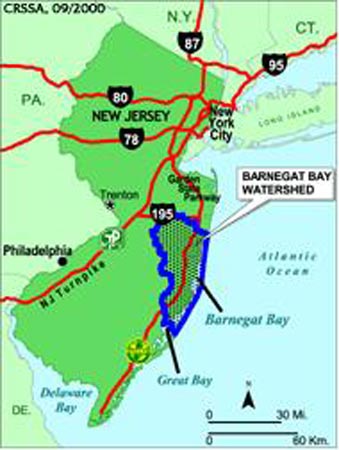A summertime ritual for many teenagers is gassing up the lawnmower and going door to door in search of lawn-mowing jobs. But cutting the grass can be a problem for people who live along bays and estuaries. It can damage beds of seagrass, which provide food and shelter for fish, shellfish, and birds.
 Barnegat Bay watershed (in blue). Credit: David Werner
Barnegat Bay watershed (in blue). Credit: David WernerAn example is in the Barnegat Bay-Little Egg Harbor Estuary in New Jersey. It’s a narrow, shallow body that runs about 40 miles along the coastline.
Seagrass beds cover thousands of acres of the estuary’s sandy bottom. But over the last three decades, the size of those beds has decreased dramatically. And the remaining beds are threatened by changes to the estuary itself. That’s cut the production of bay scallops that live in the seagrass.
The problem is that the human population around the estuary has skyrocketed. Development has dumped fertilizers and other runoff into the estuary. That feeds brown tides and other outbreaks of algae, which reduce the amount of sunlight the seagrasses need to survive.
The solution includes limiting development around the estuary, and keeping as much of the land as possible covered with native plants, which reduce runoff.
And cutting the grass? Well, bigger lawns require more fertilizer, which runs into the bay. And when the grass is cut short, it’s easier for polluted water to run off. The grass clippings can be washed into the bay, too; as they decay, they use up oxygen. So reducing the size of the grass beds on land can help the grass beds in the estuary stay healthy.
This program was made possible by the Jacques Cousteau National Estuarine Research Reserve.

